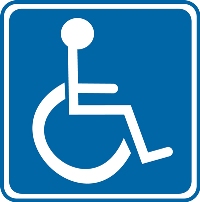ADA for Attorneys
Law firms, whether a solo practice or an AmLaw 10 firm, are all subject to the Americans with Disabilities Act of 1990 (ADA). And as lawyers know, ignorance of the law is no defense. So, here’s a quick primer on how the ADA and its California counterpart, the Unruh Civil Rights Act (Cal. Civ. Code §51 et seq.), apply to California law firms. Congress expressly included lawyers as subject to the ADA because access to justice is an essential civil right.
Background
According to the CDC, about 20% of the population or 50 million Americans have disabilities. In recognition of the prejudice, antiquated attitudes, or the failure to remove societal and institutional barriers to access for persons with disabilities, Congress enacted the ADA in 1990. Although the ADA is colloquially viewed as a liberal law, it was signed by President George H.W. Bush and passed the House on an unanimous vote and the Senate (76-8). The law was expanded by President George W. Bush in 2008 with unanimous consent of the Senate and support from the US Chamber of Commerce and National Association of Manufacturers, two pro-business groups.

Goal of the ADA
The purpose of the ADA is to extend the protections of the Civil Rights Act of 1964 to the disability community in the fields of employment and everyday access. Congress wanted to ensure the equal participation of individuals with disabilities in the “mainstream” of American society. Section 2(b) of the ADA. These included not only persons born with disabilities but people who acquired them later in life, especially veterans wounded in combat and suffering from PTSD.
For the purpose of this article, we will focus on ADA Title III: Public Access and Title I: Employment Accommodation. The other titles deal with governments and telecom providers, not lawyers.
ADA in the News
The disability community is quite frustrated that 23 years after the ADA’s passage, a substantial part of the public is still not complying with its requirements. That has, in part, led to a rise of disability access lawsuits in recent years, most notably “drive-by” lawsuits where a person with a disability and her lawyer will visit and sue scores of retail establishments in a neighborhood. Similarly, the DoJ and the disability rights community have been filing lawsuits against doctors and hospitals for access violations. Although they have not been targeted en masse, yet, lawyers are ripe for the suing because they often practice from locations that are not accessible, are woefully unaware of their obligations under the ADA and have funds to pay for a settlement including plaintiffs’ attorneys’ fees.

Title III of the ADA: Public Access
Recognizing that access to lawyers is essential for participation in the “mainstream” of American society, Congress expressly required lawyers to give equal access to the disability community. “No individual shall be discriminated against on the basis of disability in the full and equal enjoyment of the goods, services, facilities, privileges, advantages, or accommodations of any place of public accommodation by any person who owns, leases (or leases to), or operates a place of public accommodation.” 42 USC §12182(a) (General Rule). “The following private entities are considered public accommodations for purposes of this subchapter, if the operations of such entities affect commerce … (F) office of an accountant or lawyer….” 42 USC §12181(7) (Definition of Public Accommodation).
There are two broad categories of public access: removal of physical barriers and modifying policies/practices, such as providing a sign language interpreter or permitting the entry of a service animal. Given its breadth, the latter will be covered in a separate article.
ADA Access in a Nutshell: Physical Barriers
So, what do lawyers have to do to comply with the ADA physical barrier limitation? They have to remove architectural barriers when it is “readily achievable”, which is defined in the statute as “easily accomplishable without much difficulty or expense”. This could include widening hallways/doorways to accommodate wheelchairs, changing doorknobs, or rearranging furniture. The test is based on the size and resources of the business.
The DoJ’s ADA website: www.ada.gov is a great starting place to see what changes a business might need to make. Its Primer for Small Businesses provides real-world advice with illustrations and examples. Overall, it is a balancing test based on cost and practicability. For example, if the cost of installing a ramp at a small restaurant would be prohibitive, the restaurant could provide take-out service. Likewise, a lawyer could offer to meet a potential client with disabilities in an accessible location (i.e. coffee shop or the client’s home/workplace).
Contrary to most people’s belief, the test is not marginal cost vs. marginal benefit (the cost of the providing access vs. the revenue from this particular client). Instead, the cost is weighed against the provider’s resources and total income. Therefore, a restaurant with $1M of revenues may be required to install a $5k ramp in order to sell 99-cent tacos.
The DoJ Is Not Moving the Goalposts
The DoJ has tried to reduce the cost of compliance. For example, if the existing building/office complies with the ADA Standards for Accessible Design published in 1991, then those elements would not have to be made compliant with the 2010 update. By example, light switches would not have be moved down from 54 inches (1991 Standard) to 48 inches (2010 Standard) — switches at 48 inches are easier to reach from a wheelchair. See more examples in the DoJ’s Primer for Small Businesses.
But I’m Just the Tenant
Lawyers typically lease space from a landlord and thus do not have control over the accessibility of the building. Nevertheless, both the tenant and the landlord could be liable under Title III of the ADA because it applies to “any person who owns, leases (or leases to), or operates a place of public accommodations”. 42 USC §12182(a). By operating a law practice in a non-accessible location, the law firm opens itself to a suit. The reality, however, is that a tenant would file a cross-complaint against its landlord so that all interested parties are involved.
Tax Incentives
In recognizing that society benefits when persons with disabilities are given access, Congress agreed that the public should bear some of the cost of the remediation through tax credits and deductions. The Disabled Access Credit applies to businesses with 30 or fewer full time employees with total revenues of less than $1M in the past year. It covers such expenses as removing barriers, providing sign-language interpreters and making written materials accessible (i.e Braille, large print, audio recording). Section 190 of the IRS Code provides a maximum deduction of $15,000 per year for the cost of removing architectural barriers. “A taxpayer may elect to treat qualified architectural and transportation barrier removal expenses which are paid or incurred by him during the taxable year as expenses which are not chargeable to capital account. The expenditures so treated shall be allowed as a deduction.” 26 USC §190(a)(1).
Unruh Act
The Unruh Civil Rights Act of 1959, codified in Civil Code § 51 et seq., ensures that all Californians have “ full and equal accommodations, advantages, facilities, privileges, or services in all business establishments of every kind whatsoever.” It applies to more businesses than the ADA, but for our purposes, all we need to know is that both apply to lawyers.
The Act expressly prohibits disability discrimination: “No business establishment of any kind whatsoever shall discriminate against, boycott or blacklist, or refuse to buy from, contract with, sell to, or trade with any person in this state on account of [a disability].” Civil Code §51.5(a). The standard penalty for violating the Unruh Act is at least $4,000 and at most treble actual damages plus attorneys’ fees. Civil Code §52(a). In 2012, the legislature reduced the penalties in certain circumstances discussed below.
For years, disability plaintiffs have sued under both the ADA and the Unruh Act given the latter’s minimum statutory damages and attorneys’ fees provision.
California Disabled Persons Act
In 1968, California enacted the Disabled Persons Act (codified at Civil Code §54 et seq.). The Act also prohibits discrimination based on disability in public accommodations, which a lawyer’s office is. Civil Code §54.1. The penalty for violating the Disabled Persons Act is less than the Unruh Act, which is one reason that disability plaintiffs prefer to sue under the Unruh Act. The penalty is at least $1,000 and at most treble actual damages plus attorneys’ fees. Civil Code §54.3.
The Deck Is Not Stacked Against Defendants
Small businesses often complain that the California disability rights laws are unfairly pro-plaintiff. In 2012, the California Supreme Court and the state legislature sought to balance the scales a bit. First, in response to lobbying from the business community, the California legislature enacted SB 1186 in September 2012 imposing heightened requirements on plaintiffs and plaintiffs’ attorneys in disability actions. Among other things, it prohibits plaintiffs’ attorneys from sending businesses letters identifying construction-related accessibility issues and also asking for payment. Civil Code §55.31. In addition, to minimize defense legal fess, the legislature now allows defendants to seek a stay and an early evaluation conference. Civil Code §55.54(b). It also reduces the minimum statutory fines where the violation is fixed within 30 or 60 days depending on whether the defendant is a small business or if the construction was approved by the city building department. Civil Code §55.56(f).
Second, the Supreme Court unanimously held that prevailing defendants in disability actions brought under state law are entitled to their attorneys’ fees under Civil Code §55. Jankey v. Song Koo Lee, 55 Cal. 4th 1038 (2012). This encourages defendants to vigorously defend cases where they believe they are complying with the ADA/Unruh Act and where they might be able to collect from the individual plaintiff or public interest group. In addition to the collectibility issue, judges sometimes avoid awarding fees by finding that neither party is the prevailing party as District Judge Avila recently did in the closed captioning case against Netflix.
Title I of the ADA: Employment Accommodation
Title I of the ADA and the California Fair Employment and Housing Act govern the hiring and retention of workers with disabilities. Under these Acts, the only disability-related question that an employer can ask at the time of hiring is whether the candidate can do the job with reasonable accommodation. 42 USC §12112(d)(1). The cannot ask the employee to submit to a medical examination to verify whether the employee can do the work. 42 USC §12112(d)(2).
The ADA applies to employers with 15 employees whereas FEHA applies to employers with 5 employees, so most solo and small law firms will only need to comply with FEHA. Compare 42 USC §12111(5)(A) with Cal. Govt. Code §12926(d). The EEOC has a particularly helpful FAQ website for employees with disabilities.
Highlighting the overlapping goals of federal and state law, FEHA’s goal is to:
“ensure discrimination-free access to employment opportunities notwithstanding any individual’s actual or perceived disability or medical condition; to preserve a valuable pool of experienced, skilled employees; and to strengthen our economy by keeping people working who would otherwise require public assistance. These regulations are to be broadly construed to protect applicants and employees from discrimination due to an actual or perceived physical or mental disability or medical condition that is disabling, potentially disabling or perceived to be disabling or potentially disabling. The definition of “disability” in these regulations shall be construed broadly in favor of expansive coverage by the maximum extent permitted by the terms of the Fair Employment and Housing Act (“FEHA”).” 2 CA ADC §7293.5(b).
In essence, employers must reasonably accommodate any potential or current employee with a disability. “Reasonable accommodation is any change or adjustment to a job or work environment that permits a qualified applicant or employee with a disability to participate in the job application process, to perform the essential functions of a job, or to enjoy benefits and privileges of employment equal to those enjoyed by employees without disabilities.” As with access, this is a balancing test with the burden on the employer: “An employer is required to provide a reasonable accommodation to a qualified applicant or employee with a disability unless the employer can show that the accommodation would be an undue hardship — that is, that it would require significant difficulty or expense.”
I hope that this was helpful in highlighting a lawyer’s obligations under the ADA and the Unruh/FEHA Acts.
Next, learn about: Whether to incorporate your law practice or operate as a sole proprietorship or Your liability for drunk employees.
 Shirish Gupta is an award-winning mediator and arbitrator with JAMS. He regularly mediates ADA and Unruh Act disputes. This article was written in conjunction with his & disability rights advocate Karma Quick’s presentation at the 2013 California State Bar’s Solo and Small Firm Summit.
Shirish Gupta is an award-winning mediator and arbitrator with JAMS. He regularly mediates ADA and Unruh Act disputes. This article was written in conjunction with his & disability rights advocate Karma Quick’s presentation at the 2013 California State Bar’s Solo and Small Firm Summit.
Book a mediation with Shirish.
Copyright 2013: Shirish Gupta



